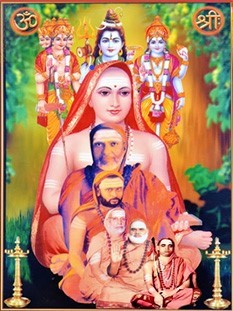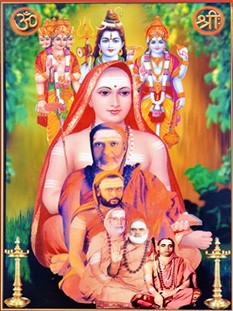Guru Parampara represents the Guru Shishya lineage, where each Guru passes on the Advaita knowledge to their disciples from one generation to another, without any change in the basic knowledge. This Parampara continues for ages and the tracing of this Advaita Guru Shishya Parampara is brought out in this Guru Parampara Stotram.
Here apart from the immediate guru, three preceding gurus are also revered, they have titled Guru (my Guru), Parama Guru (my Guru’s Guru), Paratpara Guru (Parama Guru’s Guru) and Paramesti Guru (the supreme guru, Lord Shiva/Vishnu).
Guru Shishya Parampara Lineage
The traditional lineage of Advaita gurus is traced from Daiva-parampara, (Gods from the mythological time), followed by the Rishi-parampara, (Vedic seers); and then the Manava-parampara, (historical teachers).

The following shows the Guru Shishya Parampara lineage, the yuga they belonged, their title, and their names.
Daiva-parampara – In Satya yuga or Krata Yuga – Parameṣṭhi-Guru
- Narayana (Lord Vishnu / Shiva)
- Padmabhuva (Brahma)
Rishi Parampara – Paratpara-Guru
In Treta Yuga
- Vasistha Maharashi
- Sakti Maharsi
- Parasara Maharashi
In Dwapara Yuga
- Sri Veda Vyāsa
- Sri Suka Acharya
Manava-parampara – In the Kali Yuga – Parama-Guru
- Sri Gauḍapadacharya
- Sri Govinda bhagavatpadacharya
- Sri Sankaracharya, and then Shankara’s four disciples
- Padmapadacharya
- Hastamalakacharya
- Toṭakacharya
- Vartikakāra (Suresvaracharya) and others
All other gurus trace their Parapara through one of these four disciples of Sri Shankaracharya.
Guru Parampara Stotram – When and Why do we chant?
We chant Guru Parampara Stotram while doing daily Guru Pooja, during Occasions like Guru Poornima and when we do pada pooja for any Swamij’s. We chant this as a tradition to make an invocation of the lineage who have handed the knowledge down and show our respect to that tradition.
By chanting this Stotram, we create an invitation to the Divine. We are waking up the God’s and Gurus of Advaita Parampara to our presence, and we express our gratitude and seek blessing for smooth teaching, understanding, and assimilation of self-knowledge.
Guru Parampara Stotram Lyrics with Meanings
We have two Advaita Guru Parampara Stotram, one originated from Lord Shiva and the other from Lord Vishnu. We either chant both or anyone during Guru Pooja.
Guru Parampara Stotram Lyrics – Originated from Lord Shiva
sadāśiva-samārambhāṃ
śaṅkarācārya-madhyamām.
asmadācārya-paryantāṃ
vande guru-paramparām ||
I bow with reverence to the Guru Parampara lineage starting with the all-pervasive Lord Shiva consciousness (Sadasiva) with Adi Sankara in the middle and all those teachers up to my own Guru.
Lord Shiva is also called Sada Shiva, which means that which is true, never changes, real, all-pervading, and always available.
Samarambhamba means ‘in the beginning’, that sada shiva consciousness/ existence principle was available even before the world got created. It is Eternal and is beyond time principle.
Shankaracharya Madhyamam means that Sri Adi Shankaracharya came in between now and the at the beginning of the time, he redefined, reorganized and reclarified the Advaita teaching and reduced this teaching to a simple straightforward statement: “Brahma Satyam Jagad Mithya Jivo Brahmaiva na parah”.
Asmad Acharya Paryantam – All other Guru’s and at the bottom, now, is my Guru (acharya).
Vande Guru Paramparam – I respect and worship to this flow of knowledge from the Lord to all other Guru’s in the Parampara and to my own present Guru.
Guru Shishya Parampara Stotram Lyrics – Originated from Lord Vishnu
Narayanam, Padmabhuvam, Vashishtam,
Shathim Cha Thathputhra Parasharam Cha,
Vyasam, Shukham, Goudapadam Mahaantham,
Govinda Yogindram Athasya Shishyam,
Sri Shankaracharyam Athasya Padma
padam Cha Hasthamalakam Cha Shishyam,
Tham Thotakam Varthikaramanyan
Asmad Gurun Santhathamanathosmi ||
śruti smṛuti purāṇānām ālayam karuṇālayam
namami bhagavatpadam Sankaram loka sankaram|
śaṅkaraṃ śaṅkarācārya keśavaṃ bādarāyaṇam
sūtra-bhāṣya-kṛtī vande bhagavantau punaḥ punaḥ|
Yadvare nikhila nilimpa parishad siddhim vidattey nisham
Shrimath Shree lasitam Jagad Guru padam natvatma truptim gataha|
Lokagnana payodha patanadhuram Shree Shankaram sharmadam
Brahmananda Saraswatim cha Shri Brahman dhyayami jyotir mayam|
Asmad Gurun Santhathamanathosmi – I offer my salutations to all our gurus, the entire guru shishya paraṃpara, santataṃ means always. And what is this guru paraṃpara? It starts from Nārayaṇa, Lord Viṣhṇu is the first acharya. Then as per the purana’s, Lord Vishnu through is navel created Brahmaji seated on the lotus flower. In one of the Shanti mantra “yo Brāhmaṇam vidadati pūrvaṁ” it is explained that Lord Viṣhṇu created Brahmāji also called Hiranyagarbha (cosmic intelligence). So since Brahmaji appeared out of lotus, he is called Padmabhuḥvam. Hence, he became the first disciple of Lord Narayana and they both belong to Daiva-parampara in Satya yuga
And the third acharya is Vasistata Maharishi, who is the disciple of Lord Brahma and he happens to be Brahmaji’s manasa putra (son) as well. He is the most revered vedic rishis and one among the Saptarishi’s. He is the first Vedantic Sage and He was one of the authors of “Rig Veda”.
Vasiṣta Maharishi’s Sisya is Sakti Maharishi, who is also the son and disciple of Vasiṣta. Śakti Maharishi’s putra happens to be Parasara Maharashi, who is the next acharya. Sage Parashara has contributed many verses in the Rigveda. He is the author of Vishnu Purana and he his also regarded as the Father of Vedic Astrology.
All these three Maharashi’s belongs to Rishi Parampara in Treta Yuga.
The next as per Guru Parampara Stotram Lineage is Sri Ved Vyasaḥ, who happens to be putra and Sisya of Parashara Maharshi. Few of Vyasa’s works involved
1) Arranging the Vedas as three paths of Karma, Upasana (devotion) and Jnana (knowledge)
2) He authored Brahma Sutras which helped in quick and easy understanding of the Shrutis
3) He wrote the Mahabharata and made common people understand the highest knowledge thoroughly.
4) Vyasacharya also wrote about Lord Narayana and his avatars in Bhagavatam, which is a most sacred book and is highly revered by the devotees of Lord Vishnu.
The next in the Lineage is Suka Acharya, he is the disciple and son of Sri Ved Vyasaḥ. He is the main narrator of the scripture Bhagavata Purana. He recited the story to the king Parikshit in his final days. He also had mastered the Vedaanga’s.
Both Maharashi’s Ved Vyasah and Suka Acharya belongs to Rsi Parampara in the Dwapara Yuga.
The next Guru belonging to Guru Parampara Lineage is Sri Gauḍapādacharya, the great author of Kārikas; a commentary in verse form on the Mandukya Upanishad. His disciple is Govinda Yōgindram known as Sri Govinda Bhagavatpādacharya who is a preceptor in Advaita Vedanta and had mastered Vyakarana. His disciple is Sri Adi Shankaracharya.
Sri Adi Shankaracharya is considered one of the most influential philosophers and religious leaders in Hinduism. He contributed to the development of Advaita Vedanta.
His works include the writing of Bhashyam (commentary) for various Upanishads and Brahma Sutra, he authored several Prakaran granthas and contributed many Bhakti Slokas and Meditation verses in praise of Lords Vishnu, Shiva, and Shakti.
Sri Shankara with disciples
Of the large number of disciples of Sri Adi Shankaracharya, the following four disciples stands out eminent. Padmapadacharya for his intense devotion; Hastamalakacharya, for supreme self-realisation Tottakacharya, for exemplary service and Vartikakaracarya for deep learning.
Padmapadacharya – He paved the way for the methodological analysis of Advaita Vedanta. For him, his Guru’s command was everything. It is said in the scriptures that, when his Guru called from the other side of the river, he did not wonder how to cross the river, he just walked through the river, wherever he placed his foot, the lotus appeared and served as a lotus-bridge, that was his guru-bhakti and therefore he got the name Padmapadacarya.
Hastamalakacarya – He was heading the Dvaraka Pitham, the monastery founded by Adi Shankara in Dwaraka. It is said that the knowledge of the Self was so natural to him like holding an Amalaka fruit (Amla) in one’s hand and not missing seeing it, hence he was named Hastāmalaka.
Tottakacarya, was hardly interested in learning but was very loyal, humble, and completely devoted to his guru. Shankaracharya then decided to reward him for his devotion and mentally transferred all his knowledge. Guru’s grace made him a Jnani. Tottakacarya later composed a poem in totaka metre named ‘Tottakashtakam’, this poem was in praise of his Guru Adi Saṅkara. He was also made the first head of the Jyotir Pītham
Vartikakaracarya (Sureshvaracharya) – He was a great scholar and a reputed philosopher. He has written Vārtikam (critical commentary) on various Upanishads, which made him famous. He was heading the Sringeri Sharada Peetham, established by Sri Shankaracharya.
Further Guru Parampara Storam says that all these four disciples and there afterward their subsequent lineage also continue. All the other ācāryas up to my guru; all of them are asmat gurūn; all of them are my teachers. Some of them directly; some of them indirectly; ānathōsmi; all of them I worship.
Sruti smṛuti puraṇanam alayam karuṇalayam
Namami bhagavatpadam Sankaram loka sankaram
My special namaskārams to Shankaracharya who is a temple (alayam) of all the Vedas (Śruti), systematic presentation of all Vedic texts (Smriti), and who had Puranic wisdom (purananam). All Sruti, Smriti, and puranam together abide in one shrine (Alayam) which is Sri Shankaracharya.
He was a person of great compassion and openly shared knowledge with others and hence called karunalayam.
Namami bhagavatpadam sankaram lokasankaram – I offer my prostrations to that Shankaracharya, who helps people to merge with Bhagavān (Bhagavatpadaḥ), and who brings auspiciousness to the entire world through his teaching (Lokasankarah).
Sankaram sankaracarya kesavam badarayaṇam
Sutra-bhāṣya-kṛti vande bhagavantau punaḥ punaḥ
Offering prostrations to Shankaracharya and Vyasacharya; both are the avatāras. Lord Shiva alone has taken the avatāra as Ādi Śaṅkara and Lord Vishnu as bādarāyaṇam (Vyasacharya). Lord Viṣṇu (Vyasācārya) wrote the Brahma Sutram and Lord Shiva (Shankaracharya) wrote the Brahma Sutra Bhasyam. I offer infinite namaskarams to both.
Yadvare nikhila nilimpa parishad siddhim vidattey nisham
Shrimath Shree lasitam Jagad Guru padam natvatma truptim gataha
I bow to the seat of those Universal Masters at whose doorstep all kinds of deities and divine beings shower fulfillment, I bow to these masters and attain contentment.
Lokagnana payodha patanadhuram Shree Shankaram sharmadam
Brahmananda Saraswatim cha Shri Brahman dhyayami jyotir mayam.
I meditate upon the bright form of my Guru, Sri Brahman, who is a divine bliss, nurturing, and expert in dispelling the ignorance of this world.
Conclusion and Benefits
- Daily Chanting of the Guru Parampara stotram helps in remembering these Gurus and strengthens our bond with the Guru. The Grace of the entire Guru-Parampara flows through us and this will help the spiritual seeker to progress in the spiritual path without any obstacles.
- Guru Parampara Stotram is a praise of all the Gurus in the Parampara who has blessed us with the Vision of Self Knowledge, through their scriptures, commentaries, and teachings. It is also being grateful to all the Gurus & the Lord for supporting us with the right environment and the right teaching in our Spiritual Journey
- Repeated chanting reinforces faith in the Guru which leads to a smooth spiritual journey, assimilation of knowledge gained, and Liberation.
- The Namagiri Thayar Mantra – For Wisdom, Creativity & Prosperity - April 29, 2024
- Krishnashtakam – “Krishnam Vande Jagadgurum” – Lyrics & Meaning - April 4, 2024
- Karadarshanam – “Karagre Vasate Lakshmi” – Meaning & Benefits - March 26, 2024


0 Comments
Trackbacks/Pingbacks